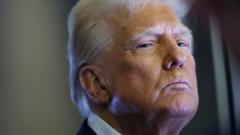As President Donald Trump journeys from Las Vegas to Miami aboard Air Force One, he engages with reporters, exuding confidence in his actions since resuming office. With the in-flight screens showing Fox News, he asserts his administration’s accomplishments, declaring, "We're getting A-pluses on the work done." His bold statements reflect a dramatic shift in political dynamics since his return, where he has already undertaken substantial modifications to government policies.
During a candid discussion with journalists, Trump detailed his recent decisions, including a late-night purge of government watchdogs and aspirational comments concerning Greenland. He boasted about his relationships with foreign leaders and exhibited a bold persona that differs from his predecessor Joe Biden’s more reserved media interactions. Instead of traditional symbols of transitional power, Trump’s revival represents a broader shift in governance, demonstrating his intent to dismantle Biden’s legacies swiftly.
Upon his return, Trump reinstated familiar artifacts in the Oval Office, but the significance lies in the political momentum behind his actions. From a stacked desk with leather-bound executive orders to his sweeping legislative actions, Trump’s administration is marked by a proactive approach, giving little regard for the past. With Congress firmly in GOP hands, the political landscape has emboldened Trump to proceed with greater disregard for his political opponents.
Amid a narrative-shifting recalibration, Trump has undertaken rapid governance changes, such as pardoning over 1,500 supporters linked to the Capitol riot. Additionally, he moved to restore his political footprint by renaming the Gulf of Mexico and pulling out of international climate commitments. This decisive move is born out of his new-found freedom as a seasoned politician, illustrating a firm departure from his earlier outsider status.
A contrast to his first term, Trump's second administration seems more organized and prepared, with a core team of unwavering allies who are eager to implement a robust agenda. His first-day actions, which dwarfed those of his predecessor, signal a willingness to challenge norms while prioritizing immigration, climate policies, and administrative reform.
Former administration insiders point out that this time Trump’s team appears to learn from past mistakes, embracing a more coherent strategy for governance. As many policies are tailored to avoid previous legal pitfalls, optimism prevails within Trump’s circle regarding more sustainable change across an array of issues.
In summary, Trump 2.0 embodies a relentless advance for a president who has faced and overcome considerable obstacles. Following an initial period of daunting setbacks, the renewed leader is preparing to redefine American politics, with an assertive agenda aimed at facilitating immediate and impactful changes to the political landscape.



















